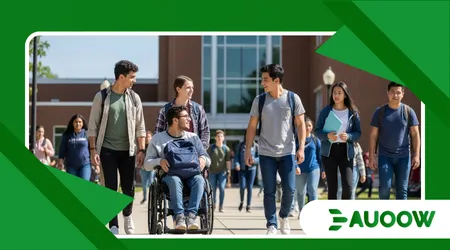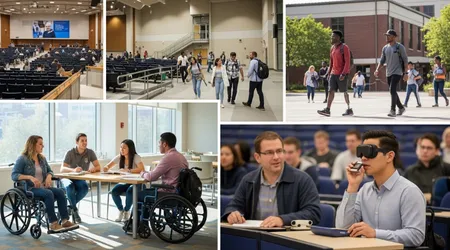Are Students with Disabilities Protected in Higher Education?

Are Students with Disabilities Protected in Higher Education is a question central to the integrity of modern academia and public policy, demanding more than a simple yes or no.
The legal frameworks protecting these students are robust on paper, primarily through the Americans with Disabilities Act (ADA) and Section 504 of the Rehabilitation Act.
However, 2025 data suggests a persistent gap between regulatory requirements and real-world institutional compliance. This disparity leaves many students struggling to achieve genuine equality of access and outcome.
Navigating the transition from high school, where the Individuals with Disabilities Education Act (IDEA) mandates the institution provide services, to college, where the responsibility shifts to the student, presents a monumental challenge.
Universities must provide “reasonable accommodations” to ensure equal access, yet the application of this standard is often inconsistent, fragmented, or, in worst-case scenarios, actively resisted.
The onus remains on the student to self-disclose and advocate relentlessly for the rights theoretically guaranteed by law.
What are the Key Federal Laws Governing Accessibility for Students?
The legal foundation for accessibility in postsecondary institutions is built upon two major pieces of U.S. federal legislation that prohibit discrimination based on disability.
Understanding their differences is crucial for anyone wondering Are Students with Disabilities Protected in Higher Education.
How Does the ADA Title II and Section 504 Safeguard Students?
Section 504 of the Rehabilitation Act of 1973 was the groundbreaking measure, stating that no qualified individual with a disability should be excluded from participation in any program receiving federal financial assistance.
Since nearly all U.S. colleges and universities accept federal funds, Section 504 applies broadly, demanding program accessibility.
Title II of the Americans with Disabilities Act (ADA) of 1990 reinforces this, specifically applying to public entities, including state-funded universities.
Both laws require schools to make necessary modifications to policies, practices, and procedures, as well as provide auxiliary aids and services.
This dual-layered protection means institutions cannot deny a qualified student admission or access to a program simply because of a disability.
They must provide accommodations unless doing so would fundamentally alter the program’s nature or cause an undue financial/administrative burden a high legal standard.
++ Latin America’s Emerging Accessibility Policies: Who’s Leading?
Why is the Shift from IDEA to ADA/Section 504 So Critical?
In K-12 education, IDEA requires schools to identify students with disabilities and provide a Free Appropriate Public Education (FAPE) with an Individualized Education Program (IEP).
College changes the dynamic entirely: the institution only responds to the student’s voluntary disclosure and request for accommodations.
This change places the burden of proof and advocacy on the student, requiring sophisticated self-awareness and self-advocacy skills.
Many students lack the tools to effectively transition to this model, leading to delays or denial of crucial supports during their first college years.
Students must provide appropriate documentation from a qualified professional to establish their disability and the need for accommodations.
The university is obligated to engage in an “interactive process” with the student to determine which reasonable accommodations are appropriate for their academic success.

What Real-World Challenges Limit Equal Access Today?
Despite the legal mandate, the pathway to obtaining equitable education is frequently marred by institutional inertia and outright resistance.
The question, Are Students with Disabilities Protected in Higher Education, becomes more complex when considering practical implementation hurdles in 2025.
Also read: How U.S. Federal Agencies Are Enforcing Web Accessibility in 2025
Why Do Students Face Delays in Receiving Necessary Accommodations?
The most common real-world barrier remains the bureaucratic delay in approving and implementing accommodations.
A student with a print disability might request textbooks in an accessible electronic format, yet the process of conversion often lags behind the start of the semester. This delay puts the student at a profound disadvantage from day one.
Furthermore, some faculty members, unfamiliar or dismissive of the law, may resist providing approved accommodations like extended time or leniency for absences related to the disability.
The student is then forced to appeal, turning their focus from academics to administrative disputes.
This friction creates a culture where students must choose between disclosing their disability, facing potential stigma and hassle, or attempting to succeed without necessary support. It’s a choice no student should have to make.
Read more: Monitoring Misinformation: The Role of Google Trends in Public Policy Research
What is the Impact of Stigma and Lack of Faculty Training?
Social stigma surrounding mental health or learning disabilities can deter students from even registering with the campus Disability Services office, fearing discrimination from peers or faculty.
Lack of comprehensive faculty training on disability laws and inclusive pedagogy exacerbates this issue.
Many professors assume an accommodation lowers the academic standard, which is legally and ethically incorrect.
A reader for an exam, for example, levels the playing field for a student with low vision, it does not offer an unfair advantage.
This lack of understanding manifests as microaggressions or outright hostile behavior, undermining the student’s sense of belonging.
The University of Nevada, Las Vegas’s Disability Resource Center reported that faculty attitudes remain a significant obstacle to full inclusion.
How Does the Lack of Digital Accessibility Create Barriers?
In the current educational climate, where hybrid and online learning environments are common, digital accessibility is no longer optional it is fundamental. Digital inaccessibility forms one of the most critical barriers today.
What are the Current Technological Hurdles for Disabled Students?
Learning Management Systems (LMS) and online course materials frequently lack compatibility with screen readers, captioning for videos, or keyboard navigation for mobility-impaired students.
When a professor posts a scanned, non-searchable PDF, they are essentially erecting a wall for a student with a visual impairment.
This issue is amplified by the rapid adoption of AI-driven educational tools in 2025. If these tools are not built with Universal Design for Learning (UDL) principles from the start, they will perpetuate and amplify existing accessibility gaps.
The legal standard is “effective communication,” meaning digital materials must be just as accessible to a disabled student as they are to a non-disabled peer.
Failure to meet this standard exposes the institution to significant legal liability and, more importantly, constitutes discrimination.
Why is Proactive Design Better Than Reactive Accommodation?
An institution relying solely on reactive accommodations fixing problems after a student points them out is fundamentally failing in its obligations. Proactive Universal Design for Learning (UDL) benefits everyone.
For instance, providing all lecture videos with high-quality captions from the outset benefits students who are deaf or hard-of-hearing, non-native English speakers, and students studying in loud environments.
It’s a pedagogical enhancement for all, not just a segregated service. Relying on accommodations alone is like designing a building with a flight of stairs and only installing a temporary ramp after a wheelchair user enrolls.
True inclusion means building the ramp or an elevator right alongside the stairs from the initial design.
What is the Statistical Reality of Student Outcomes?
Looking at enrollment numbers versus graduation rates provides a cold, hard answer to the initial question. While enrollment has surged, the success gap persists.
What Do Recent Graduation Rates Reveal About the System?
According to a 2025 report commissioned by the National Postsecondary Education Cooperative (NPEC), the prevalence of students with disabilities in postsecondary education has risen significantly, reaching approximately 21% of all enrolled undergraduates.
This demonstrates a positive trend in access. However, the graduation rate for disabled students still lags substantially behind their non-disabled peers.
While the exact gap varies by institution and disability type, the underlying statistic reveals a systemic failure in retention and support, showing that equal access to the front door does not equate to equal success upon exiting.
This disparity proves that compliance with the letter of the law providing a basic accommodation does not equate to compliance with the spirit of the law ensuring equal opportunity for academic success.
Types of Reasonable Accommodations and Their Impact
Reasonable accommodations must be individualized and determined through the interactive process. They are modifications, not lower standards.
| Accommodation Category | Examples of Practical Application | Intended Barrier Removed |
| Testing Adjustments | Extended time on exams, minimal-distraction setting, alternative exam format (e.g., oral exam). | Time pressure, environmental distraction, writing speed deficits. |
| Classroom Access | Note-takers, permission to record lectures, accessible furniture, priority registration. | Difficulties with handwriting, attention, auditory processing, and physical mobility. |
| Material Conversion | Textbooks in accessible electronic format, captioned videos, Braille documents. | Visual or auditory processing barriers, ensuring “effective communication.” |
Conclusion: A Call for Cultural and Structural Change
Are Students with Disabilities Protected in Higher Education? Legally, yes. Practically, the protection often fails to translate into equitable experience and outcomes.
The laws are not the problem; the institutional and cultural implementation is. For true inclusion in 2025, universities must pivot from a minimum-compliance mindset to one embracing Universal Design, making accessibility a default setting rather than a specialized, separate service.
The persistence of the achievement gap is a constant, irrefutable indictment of the status quo. Is it not time for institutions to lead, rather than merely comply?
We need active institutional champions and robust training to embed disability justice into the curriculum and campus culture.
Share your experience with campus disability services in the comments below your stories drive necessary change.
Frequently Asked Questions (FAQ)
Does a college have to accept my old high school IEP?
No, colleges are not legally required to implement an IEP. They require updated documentation from a qualified professional (e.g., doctor, psychologist) to determine eligibility under ADA/Section 504. The focus shifts from “educational benefit” (IDEA) to “equal access” (ADA/504).
Can a professor legally deny an accommodation approved by the Disability Services Office?
No. A faculty member cannot override an accommodation officially approved by the university’s designated Disability Services Office (DSO).
If a professor refuses, the student must immediately contact the DSO, which is responsible for enforcing the approved accommodation.
What should I do if a university delays my requested accommodation?
Document everything: the date of your request, the accommodation approved, and the date of the delay. Contact the DSO and request a clear timeline for implementation.
If the delay significantly impacts your studies, you can file an internal grievance with the university or a formal complaint with the U.S. Department of Education’s Office for Civil Rights (OCR).
Can I request accommodations for a temporary disability?
Yes. Temporary conditions such as a broken arm, a severe concussion, or a short-term mental health crisis that substantially limit a major life activity (like writing or walking) often qualify for temporary accommodations under Section 504. You must still provide appropriate medical documentation.
